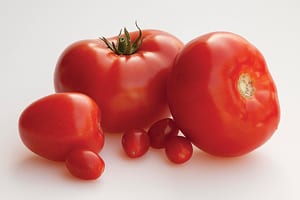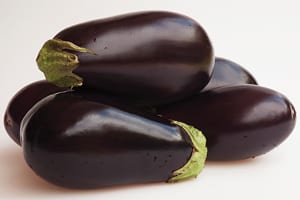NOGALES: ONE COMMUNITY’S FRESH LEGACY
October 2, 2018 | 12 min to read
Underlining its historical significance, Nogales, AZ, has become a central hub for nearly one-third of all fresh produce imports from Mexico, accounting for 6.14 billion pounds in 2017. With its strategic location, a diverse array of commodities, and a commitment to continuous improvement, the Mariposa Port of Entry enhances the efficiency of produce crossings. Despite facing rising costs and regulatory challenges, the close-knit community remains dedicated to innovation and collaboration to maintain Nogales as a vital business locale.

Originally printed in the October 2018 issue of Produce Business.
Experience, innovation and a shared sense of service position Nogales as the go-to port for nearly one-third of all Mexican imports.
For more than a century, Nogales, AZ, has served as an avenue to connect growers from Mexico to U.S. buyers and vice-versa. “Nogales has a long history in the produce business unlike many other ports,” says Matt Mandel, vice president of operations for SunFed in Rio Rico, AZ. “Rail cars of Sonoran melons were arriving to Nogales over 100 years ago.”

Mandel adds the port has been, and continues to be, primarily built around fresh fruits and vegetables coming from the largest production regions in Mexico. “The community as a whole is focused on fresh produce and has a culture of service around it I have not seen in other areas,” he says.
According to statistics provided by the Fresh Produce Association of the Americas (FPAA) in Nogales, with U.S. Department of Agriculture data, in 2017 the area accounted for 31 percent of imported volume of fresh produce imports from Mexico, or 6.14 billion pounds.
Nogales is situated at the northernmost point of a fertile growing region extending along the west coast of Mexico between the Sierra Madres and the Pacific Ocean. “We are the natural access point for crossing the variety of products being exported to the U.S. from Mexico,” says Allison Moore, FPAA vice president. “That is how Nogales was born.”
“While other ports have grown at a faster rate recently, Nogales continues to grow in both scope and volume to meet buyers’ needs across a larger swath of the calendar.”
— Matt Mandel, SunFed
 In addition to its prime geographic location, the port also boasts advantages of product diversity and expertise. “The Nogales Port of Entry handles more volume and different types of commodities than other ports,” says Pedro Batiz, vice president of sales for Divine Flavor in Nogales. “The industry there has more experience and better criteria in dealing with USDA, the Food and Drug Administration (FDA) and Customs and Border Protection (CBP) issues regarding fresh fruits and vegetables, and the level of cooperation that we have between state and local agencies helps us to address various types of problems as a community.”
In addition to its prime geographic location, the port also boasts advantages of product diversity and expertise. “The Nogales Port of Entry handles more volume and different types of commodities than other ports,” says Pedro Batiz, vice president of sales for Divine Flavor in Nogales. “The industry there has more experience and better criteria in dealing with USDA, the Food and Drug Administration (FDA) and Customs and Border Protection (CBP) issues regarding fresh fruits and vegetables, and the level of cooperation that we have between state and local agencies helps us to address various types of problems as a community.”
Nogales persists in writing its rich produce history, according to Mandel. “While other ports have grown at a faster rate recently, Nogales continues to grow in both scope and volume to meet buyers’ needs across a larger swath of the calendar,” he says.
More Than You May Think
Though historically produce imports through Nogales focused on melons and winter vegetables, the port has grown to handle and extended assortment of fruits and vegetables all year long. “Nogales’ niche is that it doesn’t really have one,” says Mandel. “The wide array of fruits and vegetables coming through the port makes for a shopper’s dream in that there are very few items grown in Mexico that aren’t crossed through Nogales.”
FPAA’s statistics log close to 60 different produce items imported throughout the year (see chart, below). “We have continued to thrive because shippers here offer a variety of fruits and vegetables important for buyers across North America,” says Moore. “From melons, squash, tomatoes, and bell peppers, to mangos, eggplant, Chinese vegetables and more, our consistent supply and diversity make Nogales a vital place to do business.”
Historically, dry veg items have been the niche for Nogales, explains Chris Ciruli, chief operating officer for Ciruli Brothers in Rio Rico. “These include cucumber, tomato, peppers, squash and eggplant. Mangos are also a big commodity. In recent years, however, more and more crossings from central Mexico have made an appearance, including avocado, berries, more tropical items and some Asian vegetables.”
In fact, Ciruli Brothers reports developing more ethnic products and growing product mix to appeal to more buyers.
A Modern Port
Nogales’ Mariposa Port of Entry is one of the most important ports of entry for produce crossings into the U.S., according to FPAA, and boasts an environment of continuous improvement to maintain the port. “Nogales has one of the newest redesigned ports of entry at the Southern Border,” says Batiz of Divine Flavor. “Roughly $225 million was spent to renovate the compound.”
Mandel relates the Mariposa Port of Entry was redesigned and re-opened in 2014. “The re-opening resulted in state-of-the-art facilities able to process nearly four times the volume the previous port was designed for,” he says. “It is also a LEED Gold-certified facility, which makes it more environmentally sustainable.”
Such modernized facilities result in easier and faster service for all involved. “Speed of crossings and loading are factors in making Nogales as important as it is for buyers,” says FPAA’s Moore.
Close proximity of facilities is another crucial factor in making Nogales as efficient as it is. “One of our biggest assets is the fact that most produce companies here are all within a 10-minute drive of each other,” says Moore. “We are like a giant terminal market, and trucks can load at multiple locations in a short amount of time. This makes it easier for buyers to source multiple items from multiple suppliers and have one truck come and efficiently create an entire load.”
Batiz explains at other ports of entry, warehouses can be located between 30 to 40 miles from the port of entry. “In Nogales, all of the warehouses are located within a 10-mile radius, allowing the trucks to reach their destination a lot sooner,” he says.
Nogales is unique in its distribution of produce warehouses, agrees Ciruli. “Their very close proximity to one another allows for sourcing from multiple people in a close area in a shorter amount of time.”
Continuing Infrastructure Improvements
Despite the accomplishment of the port renovation, the Nogales community successfully champions continuous improvement in other areas. Case in point, one of Nogales’ major produce thoroughfares is receiving funding for much-needed enhancements. “The Arizona State Transportation Board announced they will fund the full build-out and expansion of State Route 189 to the tune of $134 million,” says Moore. “SR 189, also known as Mariposa Road, is the main thoroughfare for trucks crossing the Mariposa Port of Entry in Nogales and heading northbound on I-19 to area warehouses.”
“One of our biggest assets is the fact that most produce companies here are within a 10-minute drive of each other.”
— Allison Moore, Fresh Produce Association of the Americas
FPAA estimates the road improvement should speed round-trip delivery from the port of entry to some warehouses by 20 minutes or more per truck. “This gives companies a valuable incentive to locate their operations in Nogales,” said Lance Jungmeyer, FPAA president. “It is the culmination of many years of hard work in unifying support from groups across Arizona about this important roadway. We are always looking for ways to speed up the produce superhighway that is Nogales, and this funding is an important step in our continued success.”
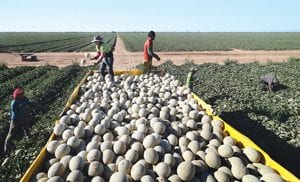 The project, fast-tracked to begin in 2019, will fund important enhancements to the entire length of SR 189 and will also construct a flyover ramp connecting SR 189 to I-19. “This will eliminate stoplights and left-hand turns that currently hamper movement of heavy trucks onto the interstate,” says Jungmeyer. “The project is also designed as a crucial safety measure by separating the ingress and egress of local high school traffic from the intersection where it meets with the commercial traffic on SR 189.”
The project, fast-tracked to begin in 2019, will fund important enhancements to the entire length of SR 189 and will also construct a flyover ramp connecting SR 189 to I-19. “This will eliminate stoplights and left-hand turns that currently hamper movement of heavy trucks onto the interstate,” says Jungmeyer. “The project is also designed as a crucial safety measure by separating the ingress and egress of local high school traffic from the intersection where it meets with the commercial traffic on SR 189.”
Jungmeyer notes the FPAA is excited about the positive benefits this will bring to its members in the form of faster, safer, more-reliable deliveries to their warehouses. “Ultimately this will be a major win for our customers and the end consumer, as well, because we will have faster deliveries of the fresh, high-quality produce that is synonymous with Nogales,” he says.
The I-19 Interchange that has been approved will alleviate a lot of traffic at the Mariposa bridge, agrees Batiz of Divine Flavor. “Trucks will be able to get on the freeway without waiting for traffic lights to turn,” he says. “The Mariposa Port of Entry is always looking for new and better technology to improve trade and commerce.”
Nogales also enjoys increased investment and development in cold storage as the industry continues to grow. “Nogales is going through a boom,” says Ciruli. “We are seeing a lot of new construction and land being developed for additional warehouse space. One reason we are seeing this growth spurt is to fill demand for consolidation, which will also help streamline transportation by having trucks minimize the number of pickups in town.”
Beyond the Physical
The Nogales community also works beyond just physical improvements to ensure smooth movement of cargo and business due to programs and communications. “Not only is Mariposa the most modern, newest, sophisticated port, we are also the birthplace of the Unified Cargo Processing (UCP) program implemented by U.S. CBP and Mexican Customs,” says FPAA’s Moore.
According to Moore, the UCP program brings together both U.S. and Mexican Customs officials in the U.S. port of entry to conduct joint inspections on trucks crossing the border. “That significantly decreases crossing times by eliminating duplicative inspections on either side of the border,” she says.
Unified Cargo Processing has been an absolute win-win for everyone involved asserts SunFed’s Mandel. “Anytime you are able to minimize bureaucracies while still maintaining the highest levels of scrutiny and security, everyone benefits,” he says. “By having the Mexican and U.S. customs operations unified, there are actually fewer opportunities for interdiction of loads leading to a more secure, and more efficient, supply chain.”
Moore believes it is no mistake this program was started in Nogales. “We are known across the country as a place of innovation birthed by the need to improve processes to move perishable goods across our border faster all while enhancing security and safety,” she says.
And, innovation doesn’t just happen on the Federal level. “We also work closely with the Arizona Department of Transportation (ADOT) on their International Border Inspection Qualification (IBIQ) program,” says Moore. “ADOT is increasing safety and efficiency through this program which offers commercial drivers from Mexico the tools and training to better comply with state and federal transportation safety requirements.”
Moore reports the program has trained more than 400 commercial drivers in the program’s first year. “And, they have scheduled an additional six training sessions in the remainder of 2018 to take place in Mexico,” she says. “This is another important example of how Nogales creates innovative, collaborative processes to ensure the safe, efficient flow of fresh produce across our border.”
Forward-thinking Nogales industry members are also broadening their focus in food safety. “During the past few years, food safety has been a huge issue with every importer at the Nogales port,” says Divine Flavor’s Batiz. “Everyone is investing a lot of time, effort and money to ensure the growers are up to standards. The Foreign Supplier Verification Program (FSVP) procedures have been updated, and it’s incredibly important for companies to follow these rules and regulations.”
An Intertwined Community
Nogales remains a tight-knit community of produce industry professionals, and while individual companies compete, they also work closely together to improve the business environment for everyone. “From improved border crossings to industry training for new regulations and laws, Nogales uniquely exemplifies the best of an industry coming together for the benefit of all,” says Moore. “This translates into quantifiable benefits for buyers when they are looking for the most efficient, professional places to source produce. It is not uncommon for two different suppliers to be competing for business in the morning and cheering together in the afternoon watching their kids play on the same baseball team.”
“We are also neighbors with the high-volume produce regions of Sonora, Sinaloa, Nayarit, Jalisco and other states of Mexico.”
— Pedro Batiz, Divine Flavor
Nogales is a small town, and produce distributors traditionally have been family-owned, explains Ciruli. “Across the generations, these families’ children grew up together and remained friends despite competing with one another,” he says. “What sets the community apart is the fact that Nogales shippers band together to ensure the area continues to see more imports, more exports and overall better infrastructure. We want the community to thrive for generations to come.”
Nogales’ perspective of being a “greater” community beyond just its borders amplifies the potential its industry offers. “We are the same city on both sides of the border,” says Batiz. “We are also neighbors with the high-volume produce regions of Sonora, Sinaloa, Nayarit, Jalisco and other states of Mexico.”
Because of this, Mandel of SunFed notes, Nogales has a concentration of growers/shippers not seen at other ports of entry. “In a 20-mile radius, you have the harvest of the finest fruits and vegetables and are able to mix and match to build loads no matter what products you’re shopping for,” he says.
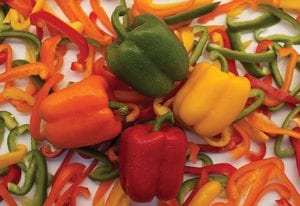 Nogales companies are aware of exacting buyer demands and believe their growers in Mexico continue to meet and exceed those demands to stay relevant. “Mexico continues to create and implement new technologies in growing and harvesting, from the use of greenhouse technology to studying better methods in agronomy, seed varieties and more,” says Moore. “The produce industry relies on innovation to continue to meet buyer and consumer demand.”
Nogales companies are aware of exacting buyer demands and believe their growers in Mexico continue to meet and exceed those demands to stay relevant. “Mexico continues to create and implement new technologies in growing and harvesting, from the use of greenhouse technology to studying better methods in agronomy, seed varieties and more,” says Moore. “The produce industry relies on innovation to continue to meet buyer and consumer demand.”
The produce industry in Nogales and the community in which it resides remain linked together. “Nogales truly is built around the produce industry, and its legacy are what have allowed the community to grow,” says Mandel.
Santa Cruz County, where Nogales resides, is a typical rural county where economic funding and opportunity are limited. “Here, 21.9 percent of the county lives below the poverty line,” says Mandel. “Our county has an unemployment rate more than double the national average. The produce industry is the largest private employer in the county, and the principals of nearly all the major companies here serve on one or more boards for non-profits aiming to better the community.”
Facing Down Tough Obstacles
Jodean Robbins
The Nogales industry gears up to continue confronting rising difficulties in costs, regulations and politicking.
Despite the significant achievements the Nogales community has logged in recent years, challenges remain. The first of those includes adequate staffing of newly improved facilities. Allison Moore, vice president of the Fresh Produce Association of the Americas (FPAA) in Nogales, AZ, reports the association continues to work with Customs and Border Protection (CBP) on a federal level to improve hiring and recruitment processes to fully staff their ports of entry across the United States. “We do a lot here through collaboration and innovation in Nogales, but that doesn’t take away the need for adequate CBP officers at our ports of entry,” she says.
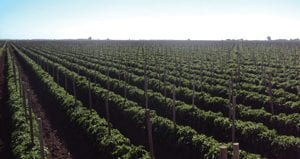 Having adequate and well-trained staff throughout all levels of the industry remains a major goal. Chris Ciruli, chief operating officer for Ciruli Brothers in Rio Rico, AZ, explains one of the challenges facing the Nogales area is bringing and retaining trained and technical labor. “We hope joint efforts with local colleges and universities will enable access to education for the local community, creating more opportunity for residents and employers alike,” he says.
Having adequate and well-trained staff throughout all levels of the industry remains a major goal. Chris Ciruli, chief operating officer for Ciruli Brothers in Rio Rico, AZ, explains one of the challenges facing the Nogales area is bringing and retaining trained and technical labor. “We hope joint efforts with local colleges and universities will enable access to education for the local community, creating more opportunity for residents and employers alike,” he says.
Though the Nogales community continues to work on improvements in roadways and facilities in the U.S., additional broader initiatives remain crucial, as well. “Infrastructure is always an issue when it comes to dealing with high volumes of produce coming in every day,” says Pedro Batiz, vice president of sales for Divine Flavor in Nogales. “We need the infrastructure on both sides to be considered equally efficient.”
Lance Jungmeyer, FPAA president, points to the increasing importance of trade facilitation. “We want to shrink the border process to make things more efficient,” he says. “Initiatives such as unified cargo processing agreements help augment ground transport efficiencies. Inspectors from both countries might be working from the same facility to create efficiencies and reduce waiting times.”
Overshadowing these challenges looms the political climate in both countries, adding layers to an already complex environment. “Perhaps the greatest challenge for the Nogales area has been the administration changes over the past 18 months, both in the U.S. and Mexico,” says Ciruli. “In Nogales, we are stuck somewhere in the middle, advocating for open trade,” he says.
Another big hurdle facing Nogales, and the produce industry as a whole, is that of increased regulations driving up costs states Matt Mandel, vice president of operations for SunFed in Rio Rico. “Specifically, freight is a real challenge,” he says. “Increasing freight costs limit product competitiveness and freshness to the end consumer. We are also in a period of deflationary pricing with increased cost inputs; something has to give.”
Seemingly innocuous regulations such as the E-log trucking requirements result in significant complications. “Before the truck-driver-limited-hours law, a truck was able to reach Los Angeles in one day with checking and loading times included,” says Batiz. “Now, with that new law, it takes about two days to get to Los Angeles.”
Volume of Mexican Produce imported through Nogales in 2017
(Percentage in 10,000-lb. units)
| Mexico | 1,987,674 | 100% |
| Nogales | 614,347 | 31% |
The top volume of produce by type:
| Commodity Name | Units |
|---|---|
| Watermelons Seedless | 100,754 |
| Cucumbers | 80,527 |
| Squash | 76,404 |
| Round Tomatoes | 56,032 |
| Bell Peppers | 54,373 |
| Plum Tomatoes | 53,893 |
| Grapes | 37,803 |
| Other Peppers | 26,729 |
| Mangos | 26,042 |
| Honeydews | 15,446 |
| Sweet Corn | 11,902 |
| Eggplant | 10,321 |
| Oranges | 9,837 |
| Grape Tomatoes | 9,727 |
| Cantaloupes | 6,938 |
| Green Beans | 5,637 |
| Misc. Asian | 5,413 |
| Bananas | 3,459 |
| Misc. Tropical | 3,023 |
| Limes | 2,825 |
| Avocados | 2,085 |
| Carrots | 1,913 |
| Cherry Tomatoes | 1,911 |
| Blueberries | 1,466 |
| Onions (dry) | 1,065 |
| Pumpkins | 1,016 |
| Grapefruit | 808 |
| Green Peas | 717 |
| Tangerines | 596 |
| Brussels sprouts | 512 |
| Pineapples | 508 |
| Asparagus | 451 |
| Other Vegetables | 448 |
| Broccoli | 431 |
| Watermelons Seeded | 420 |
| Iceberg Lettuce | 415 |
| Mixed and Misc Melons | 365 |
| Misc Herbs | 353 |
| Celery | 350 |
| Lemons | 317 |
| Peaches | 237 |
| Garlic | 186 |
| Cabbage | 169 |
| Chinese Cabbage | 136 |
| Cauliflower | 116 |
| Cactus Leaf (Nopales) | 75 |
| Green Onions | 50 |
| Radishes | 46 |
| Spinach | 30 |
| Romaine Lettuce | 24 |
Source: FPAA
6 of 30 article in Produce Business October 2018


